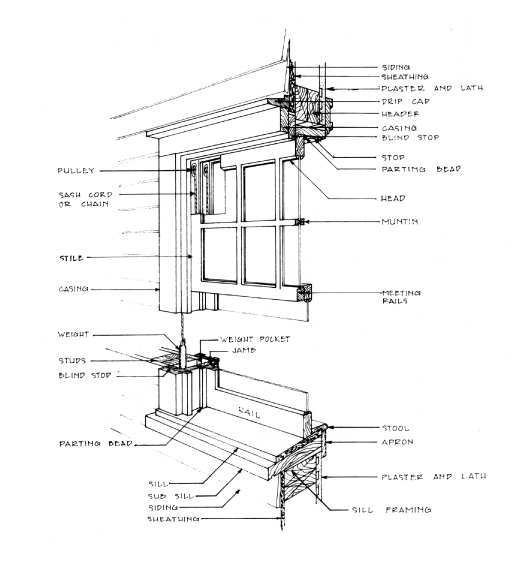With Historic Windows
Repairing and maintaining, rather than replacing, historic wood windows means long-term savings for the property owner and long-term benefit for the environment.
Related Links
• Learn the parts of a double-hung wood window. Window Repair Diagrams
• See a list of window repair tools you’ll need on hand. Window Repair Tool List
• New Federal regulations on lead-based paint mitigation don’t apply to homeowner DIY repairs, nonetheless it is important to take the proper precautions when working with lead-based paint. Lead Safe Practices (National Trust for Historic Preservation) Fact Sheet
See more detailed videos of specific repair techniques:
• Kansas State Historical Society
 Energy Efficiency Drawing by Amy Estep / reprinted courtesy City of Greensboro
Energy Efficiency Drawing by Amy Estep / reprinted courtesy City of Greensboro
In terms of embodied energy, original windows are considerably greener than “energy-efficient” vinyl replacements. And with proper maintenance, sealing, and storms, historic windows can provide the same efficiency as replacements, with a much smaller environmental impact overall.
Across the country, owners of old houses are being encouraged to remove their original windows and replace them with new energy-efficient models. Manufacturers of new window technologies advertise that old windows are inefficient, causing houses to leak energy and contributing to excessive heating and cooling bills, and to deterioration of the planet’s environment. Replacing historic windows is touted as the “green” choice, but that’s frequently not the case.
Additional Resources:
• Original sash is the greener choice! Historic Windows and Energy Efficiency by Sarah Wolff tells all . . . (PreservationNC.org)
• Replace or Restore? From Traditional Building Magazine.
• Read the New England Window Restoration Alliance’s Top Ten Reasons to Restore or Repair Wood Windows.
Some resources for keeping your original windows in good working order:
• Preservation brief about the repair of historic wood windows from the National Park Service

